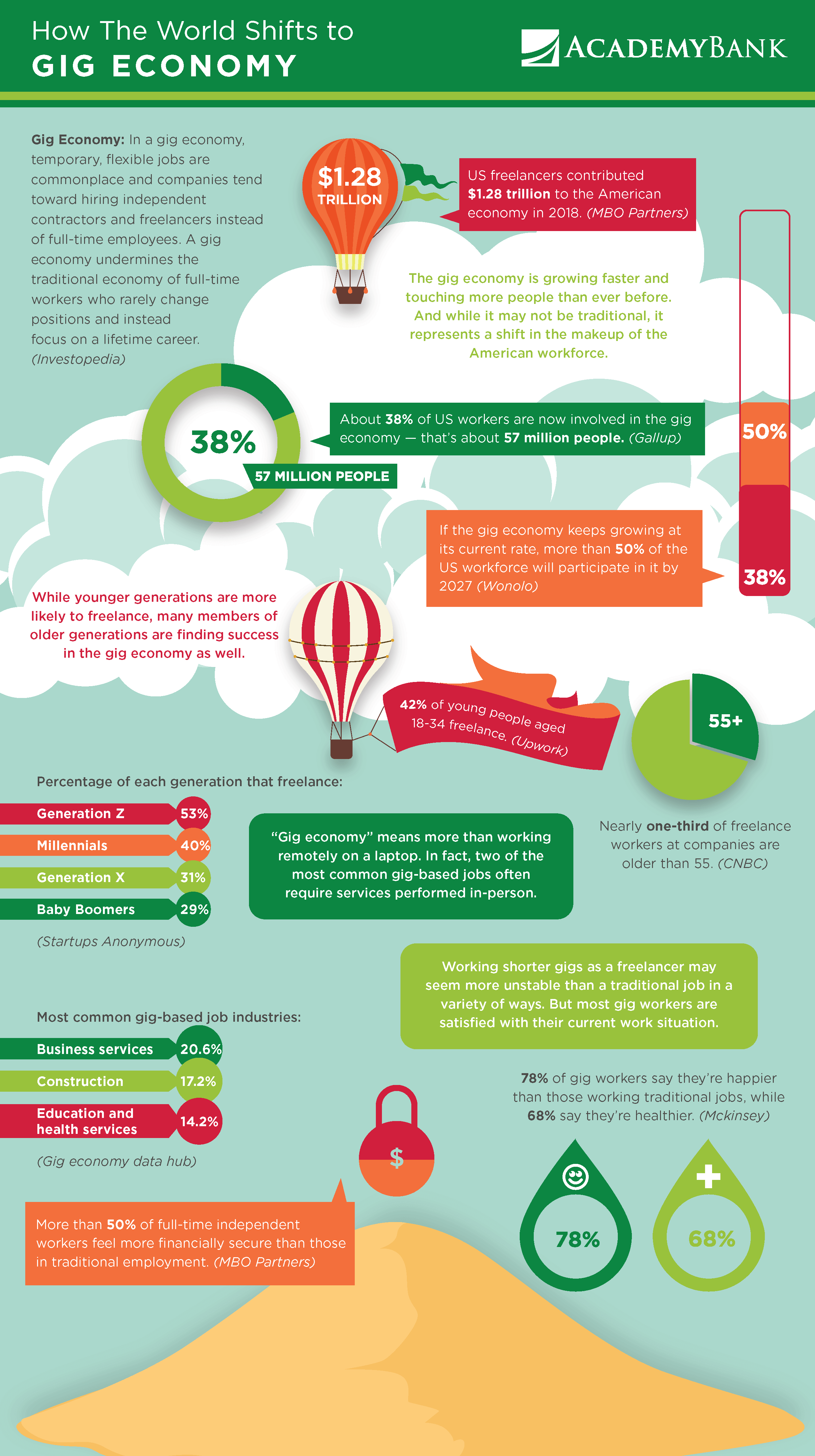
Contact Us
Bank Routing Number
107001481
Bank by Mail/General Mail
PO Box 26458
Kansas City, MO 64196
Deposit Only Mailbox
PO Box 26744
Kansas City, MO 64196
Phone Number
1-877-712-2265
Download our app
Access your
accounts here.
accounts here.

Grab your phone and scan the code to download!
not featured
2021-02-11
Savings
published
How the Gig Economy is Shaping the U.S. Workforce

-
-
.png)
As the coronavirus pandemic has impacted nearly every aspect of our lives, one area in which many of us are experiencing change is with our jobs. Millions of workers have been laid off, while others are working from home -- temporarily or permanently. For those who are jobless for the time being, many are spending hour after hour submitting job applications in the hopes of landing their next opportunity. Others are turning toward the gig economy.
The gig economy is not new, and it’s not a result of the pandemic, either. Though the pandemic may augment its impact in ways that remain long after COVID-19 is over. In the gig economy, workers focus less on traditional, full-time jobs and more on flexible positions.
Whether it’s a contract writing job for an international corporation or driving for a ride hailing company, the gig economy covers a wide variety of industries. And it’s here to stay.
Keep reading to learn more about the gig economy: what it is, who’s part of it, what work they’re doing, and how happy they are.
A Shift in the American Workforce
“In a gig economy, temporary, flexible jobs are commonplace and companies tend toward hiring independent contractors and freelancers instead of full-time employees. A gig economy undermines the traditional economy of full-time workers who rarely change positions and instead focus on a lifetime career.” -- Investopedia
The shift in the American workforce began years before COVID-19. According to a Gallup poll, as of August 2018 -- nearly a year and a half before the pandemic hit the United States -- 36% of U.S. workers reported having a gig arrangement in some capacity. That’s about 57 million people. MBO Partners, a staffing firm for independent workers, ran the numbers in their annual State of Independence Report: In 2018, U.S. freelancers contributed nearly $1.3 trillion to the American economy.
While we expect to see this number grow as a result of the pandemic, its growth was predicted long before the days of social distancing and working from home. If independent work continues increasing at the same rate it did in 2018, more than 50% of U.S. workers are estimated to be part of the gig economy by 2027 (Wonolo).
Who Is Part of the Gig Economy?
If you think it’s mostly younger workers in the gig economy, you’d be mostly right. According to Upwork’s annual “Freelancing in America” study, when it comes to young workers -- defined as ages 18-34 -- 42% are freelancing in some capacity.
But freelance workers aren’t a monolith; in fact, you may be surprised by who else you’ll find in the gig economy. Nearly one-third of freelancers working as contractors at companies are older than 55 (CNBC).
That number matches up with larger statistics about Baby Boomers and the gig economy. A study by Startups Anonymous found that 29% of Baby Boomers are freelancing, compared to 31% of Generation X workers. Predictably, Millennials (40%) and Generation X (53%) workers are most likely to be part of the gig economy.
What Are Gig Economy Jobs?
When you think of freelancers, your first thought might be the trendy twenty-something working on their laptop in a local coffee shop. They might be graphic designers, software developers, or writers. While those types of freelance jobs certainly may be part of the gig economy, they’re far from the only types of work you’ll find American gig economy workers doing.
The Gig Economy Data Hub provides various statistics on gig economy workers -- from who they are, to the work they do, to their job satisfaction. When it comes to the type of work these gig workers do, the Gig Economy Data Hub gives an interesting explanation:
“Because non-traditional work is usually defined by how it’s organized rather than the content of the work, it blurs traditional boundaries. Divisions like blue collar versus white collar, manual versus intellectual labor, or service versus goods don’t necessarily apply. Work in all of these categories can be part of the gig economy, depending on how it is arranged.” -- Gig Economy Data Hub
According to their research, the top three industries for gig economy workers are Business Services (20.6%), Construction (17.2%), and Education and Health Services (14.2%).
And remember -- not all gig or freelance positions are full time. Many people are working part-time as a freelancer and may still be holding down a traditional job at the same time. Or they may be working multiple gigs.
The Gig Economy and Job Satisfaction
Gig economy jobs may seem to be inconsistent and unstable, especially compared to more traditional employment positions. However, most gig workers report a high level of satisfaction with their current work situation -- whatever it may be.
Not only do 78% of freelance workers report being happier than those working traditional jobs, but 68% also report being healthier (Mckinsey). Whether it’s from a better work-life balance, the ability to choose their own projects, or something else.
And research by MBO Partners provides another interesting data point: More than 50% of full-time independent workers feel more financially secure than those in traditional employment. Not only are many gig workers happier and healthier, but they’re also finding freelance work to be a strong source of income. Interestingly, the seeming impermanence of gig work may not be a disadvantage to freelance work from a financial perspective.
Academy Bank Is Your Partner Through it All
The gig economy is here to stay. While it may be too early to say whether freelancing is the future of work, the number of people working these “unconventional” work arrangements, whether short term or long term, is likely to continue growing.
No matter your work situation, Academy Bank is working to be your financial partner through it all. Through whatever changes life throws at you, you can count on us to be here and help you work toward all your goals.
Member FDIC.
